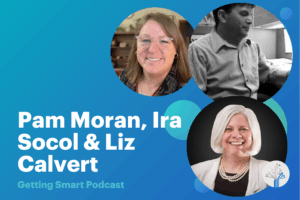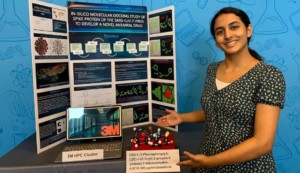Investing Today in Tomorrow’s Workforce: Michigan’s Strategy for STEM Talent

By Spencer Lucker and Megan Schrauben
With a projected shortage of 1.9 million skilled workers in manufacturing alone by 2033, the U.S. economy is on a collision course with its talent pipeline. High-demand STEM careers are the backbone of future economic growth, yet they are expanding far faster than the nation is preparing qualified workers.
As this and other workforce shifts captivate employers and governments alike, Michigan is pioneering an interconnected model that moves beyond random acts of STEM into a unified strategy centered on experiential learning. This approach unites PreK-12 education, higher education, government, workforce and industry to create continuous talent pathways and a model for others.
The pillars of Michigan’s STEM strategy
The core concept of experiential learning is simply learning by doing. The Michigan Economic Development Corporation’s (MEDC) Talent Action Team (TAT) and the Michigan Department of Labor and Economic Opportunity’s MiSTEM Network have joined forces to create the PreK-12 Strategic Investments for STEM Career Exposure partnership. This partnership provides grants to school systems across the state to test systemic and strategic models of experiential learning, employer engagement and ensure strategic alignment.
Our partnership leverages Michigan’s statewide 3P (place, project and problem-based) STEM strategy, directly connecting employers from the TAT with PreK-12 students and teachers. Our goal is to align the State of Michigan’s strategic industries with authentic, experiential learning models to inspire Michigan’s youth and build competitive, cross-industry talent pathways for future careers in advanced manufacturing, including EV and mobility, semiconductor, aerospace and defense.
To ensure accountability across all stakeholders in the talent ecosystem, our strategy integrates this core framework and addresses a dozen critical focus areas.

The results from our first round of grant funding have been inspiring. These programs benefit all parties involved: students gain relevant skills, teachers enhance their professional toolkit and businesses secure a future workforce. Let’s take a look at some of the recipients and how they’re creating opportunities for Michigan’s students.
Introducing Advanced Technology at a Young Age
To meet the nation’s critical need for semiconductor talent—the technology that powers everything from consumer electronics to advanced defense systems—a groundbreaking educational initiative is launching in Michigan’s rural Western Upper Peninsula.
The Storytelling and Semiconductors (S and S) program, rolled out to 11 classrooms in fall 2025 across 5 districts and 238 students, is designed to introduce this highly advanced subject to 4th-grade students. The program’s unique model makes this complex, abstract content accessible and engaging by using English language arts-based storytelling. The students will gain exposure to the industry and career pathways through engagement with Calumet Electronics and visits to local high school Career and Technical Education (CTE) programs.
This approach directly addresses the limited awareness of semiconductors among both young students and their teachers. By explaining what chips are, how they are used and what careers are available, S&S prepares the next generation of innovators while simultaneously equipping educators earlier in students’ educational careers.
Near-Peer Mentorship for Middle Schoolers
The Washtenaw ISD in southeastern Michigan is bringing CTE directly into middle school. The “From Curiosity to Career” program connects CTE instructors with middle school classrooms for introductory, project-based learning over nine weeks, capped off with a student-led project design. Crucially, they bring CTE high school students to serve as near-peer mentors and include local employers such as Toyota Research & Development and other advanced manufacturers as hosts for the culminating experience and project design presentation.
This mentorship seeks to dispel myths about skilled trades, showing younger students relatable peers with clear goals in technical careers and exposing them to forthcoming career pathways. By creating this accessible pathway, the Washtenaw ISD is reframing career education, bridging the traditional academic/technical divide early, and building a stronger pipeline of future CTE students.
Professional Development Camp for Teachers
It’s not enough to train our students. We must also arm our educators with the skills to be effective instructors. The Middle Vision program in Muskegon, MI, is a strategic K-12 program tackling the recruitment and upskilling of the STEM educator workforce. Teachers across Muskegon County are offered Design Thinking Professional Learning each summer from the Henry Ford Learning Institute and can then use that learning to implement design thinking pedagogy in the classroom, a skill deemed critical by most advanced manufacturing employers. Educators from three local middle schools collaborate with CTE instructors and the Career Tech Center to offer career-focused design thinking exploration for sixth graders in after-school programs. Educators gain hands-on experience, while simultaneously exploring the CTE pathways alongside their students and learning about career pathways available with local employers like Shape Corporation.
This approach creates a powerful dual benefit: it upskills teachers and exposes them to career fields while fostering a unique pathway for recruiting the next generation of STEM educators. In its first year, the program directly engaged 240 students and trained 55 teachers and coordinators.
Putting Students in the Driver’s Seat
In April 2025, the MEDC, Bosch and Southfield Public Schools launched the Bosch x Southfield Future Mobility Challenge, an EV/Mobility career prep education model. Over four weeks, more than 300 students from Glenn Levey Middle School took part in design thinking activities facilitated by Bosch team members and created mobility solutions (e.g., EVs, autonomous vehicles and drones) and online applications to solve real-world challenges that they then pitched to Bosch leadership. The industry partnership works to make advanced manufacturing concepts immediately accessible and aligned with learning, fostering early interest in the high-tech careers that need to be filled tomorrow.
Michigan is collectively addressing future talent needs across our state, from urban centers to rural communities. These innovative partnerships and education models create a systemic approach to meet the talent demands of tomorrow.
These initiatives deliver a win-win-win-win for all stakeholders:
- For students and families: Providing real-world education and hands-on career exposure at an impressionable, early age.
- For schools and teachers: Helping achieve educational standards and other requirements by upskilling staff and directly connecting to their communities.
- For companies: Supporting innovative local manufacturers to develop the essential local talent pipelines fundamental to their future success and strengthen their brand among local residents.
- For Michigan: Strengthening the state’s competitiveness, promoting advanced manufacturing career opportunities available in the state and elevating the skills of its future workforce.
And this is only the beginning. Our second round of grant recipients are beginning work this fall, and we hope this crucial partnership empowers employers and educators to collaborate on integrated hands-on learning experiences as the norm moving forward. Michigan’s approach can be a model for other states looking to future-proof their workforce and set their students up for successful careers.
Spencer Lucker is the Director of Strategic Talent Initiatives for the Michigan Economic Development Corporation (MEDC).
Megan Schrauben is the Executive Director of the Michigan Department of Labor and Economic Opportunity’s MiSTEM Network.







0 Comments
Leave a Comment
Your email address will not be published. All fields are required.